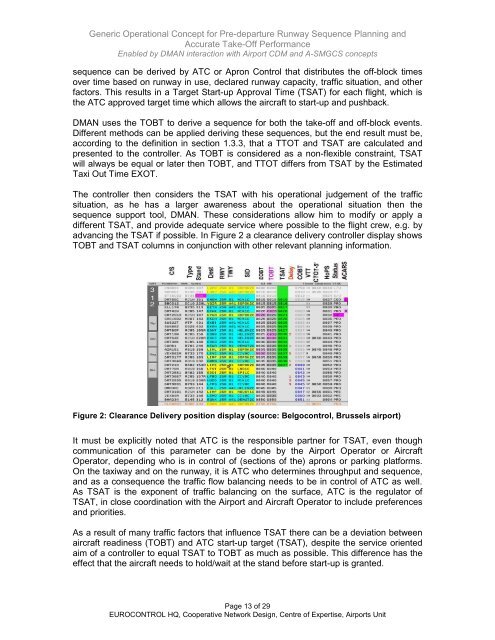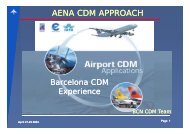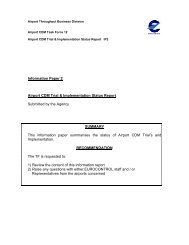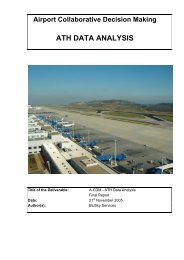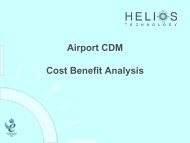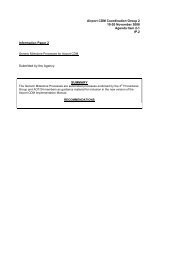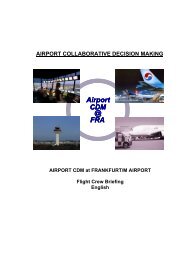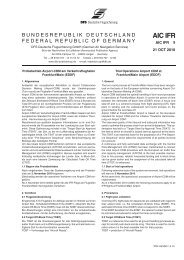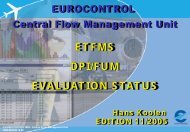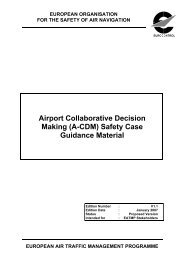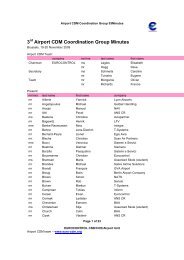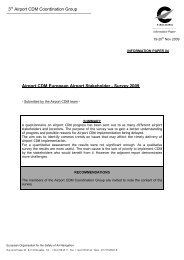Generic Operational Concept for DMAN Interaction v07A - Airport ...
Generic Operational Concept for DMAN Interaction v07A - Airport ...
Generic Operational Concept for DMAN Interaction v07A - Airport ...
You also want an ePaper? Increase the reach of your titles
YUMPU automatically turns print PDFs into web optimized ePapers that Google loves.
<strong>Generic</strong> <strong>Operational</strong> <strong>Concept</strong> <strong>for</strong> Pre-departure Runway Sequence Planning and<br />
Accurate Take-Off Per<strong>for</strong>mance<br />
Enabled by <strong>DMAN</strong> interaction with <strong>Airport</strong> CDM and A-SMGCS concepts<br />
sequence can be derived by ATC or Apron Control that distributes the off-block times<br />
over time based on runway in use, declared runway capacity, traffic situation, and other<br />
factors. This results in a Target Start-up Approval Time (TSAT) <strong>for</strong> each flight, which is<br />
the ATC approved target time which allows the aircraft to start-up and pushback.<br />
<strong>DMAN</strong> uses the TOBT to derive a sequence <strong>for</strong> both the take-off and off-block events.<br />
Different methods can be applied deriving these sequences, but the end result must be,<br />
according to the definition in section 1.3.3, that a TTOT and TSAT are calculated and<br />
presented to the controller. As TOBT is considered as a non-flexible constraint, TSAT<br />
will always be equal or later then TOBT, and TTOT differs from TSAT by the Estimated<br />
Taxi Out Time EXOT.<br />
The controller then considers the TSAT with his operational judgement of the traffic<br />
situation, as he has a larger awareness about the operational situation then the<br />
sequence support tool, <strong>DMAN</strong>. These considerations allow him to modify or apply a<br />
different TSAT, and provide adequate service where possible to the flight crew, e.g. by<br />
advancing the TSAT if possible. In Figure 2 a clearance delivery controller display shows<br />
TOBT and TSAT columns in conjunction with other relevant planning in<strong>for</strong>mation.<br />
Figure 2: Clearance Delivery position display (source: Belgocontrol, Brussels airport)<br />
It must be explicitly noted that ATC is the responsible partner <strong>for</strong> TSAT, even though<br />
communication of this parameter can be done by the <strong>Airport</strong> Operator or Aircraft<br />
Operator, depending who is in control of (sections of the) aprons or parking plat<strong>for</strong>ms.<br />
On the taxiway and on the runway, it is ATC who determines throughput and sequence,<br />
and as a consequence the traffic flow balancing needs to be in control of ATC as well.<br />
As TSAT is the exponent of traffic balancing on the surface, ATC is the regulator of<br />
TSAT, in close coordination with the <strong>Airport</strong> and Aircraft Operator to include preferences<br />
and priorities.<br />
As a result of many traffic factors that influence TSAT there can be a deviation between<br />
aircraft readiness (TOBT) and ATC start-up target (TSAT), despite the service oriented<br />
aim of a controller to equal TSAT to TOBT as much as possible. This difference has the<br />
effect that the aircraft needs to hold/wait at the stand be<strong>for</strong>e start-up is granted.<br />
Page 13 of 29<br />
EUROCONTROL HQ, Cooperative Network Design, Centre of Expertise, <strong>Airport</strong>s Unit


